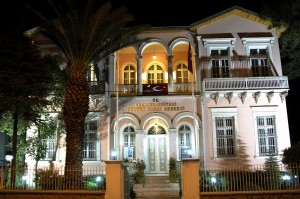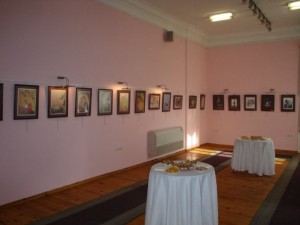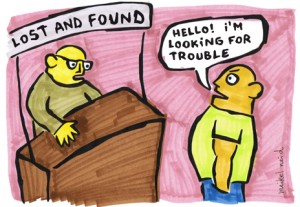
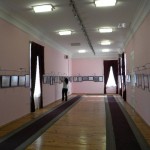
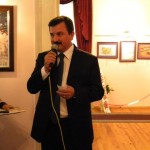
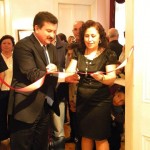
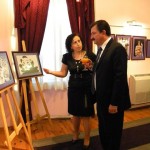
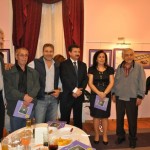
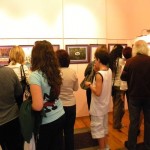
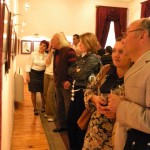
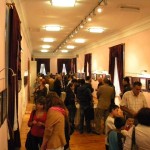
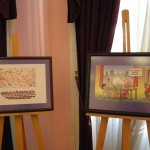
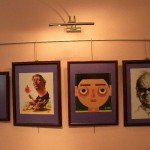
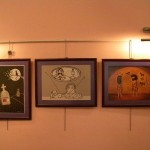
(photos used with kind permission from Menekşe Çam)
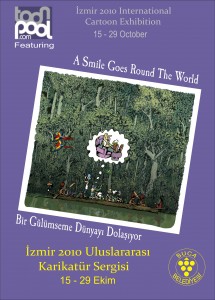 Menekşe, it’s so exciting that there will be a toonpool.com exhibition in Izmir. Can you tell me how this came into being?
Menekşe, it’s so exciting that there will be a toonpool.com exhibition in Izmir. Can you tell me how this came into being?
In fact, my husband first brought up the idea of a joint exhibition when we visited Berlin in late January. I mentioned the idea in the interview I gave back then and got very positive responses. I really want to thank Bernd Pohlenz for trusting me with the organization of the first toonpool.com exhibition in the “real world”.
Of course I also have to thank all the artists who agreed to join the exhibition and sent in their cartoons. Finally, there is the people at the BKM (Buca Municipality Cultural Center) who agreed to host the exhibition and gave us all the things we needed. Organizing this took a lot of time – more than three months. And it took a lot of hard work.
So, what is the general idea of the exhibition?
First of all, it’s a wonderful cultural event that puts the works from a great cartoon community on display for the first time. Second, the exhibition shows that this community can act together when necessary.
There is no profit in this event apart from spiritual pleasure and artistic prestige. Still, I hope that we can repeat this exhibition in other countries – after all, our slogan is “Toonpool.com – A Smile Goes ‘Round the World”
How many artists will be on display in Izmir?
It was really hard to choose between more than 80,000 artworks by almost 2,000 artists from 160 nations. In the end we had to settle for 58 cartoons by 58 artists from almost as many different countries. Among the artists on display are Matteo Bertelli from Italy, Pawel Kuczynski from Poland, An Yong Chen from China, Ernst Mattiello from Switzerland, and Xavier Salvador from Spain..
What kind of cartoons did you choose for the exhibition?
Mostly they were chosen from among the most popular cartoons on toonpool.com – the ones with the greatest number of votes and comments. Some of them are political, some funny, and some thought-provoking. There will be a catalogue, too.
Will some of the artists be present at the opening ceremony?
Yes, Buca Municipality will host ten artists in a hotel on the seaside – for two nights and three days. This includes accommodation, breakfast, and dinner. There are still some free spots.. artists who sent in their work and would like to spend a spend a weekend vacation in Izmir should just contact me.
Thanks for your time, I am really looking forward to seeing the photos taken at the grand opening!
EDIT: photos added HERE
“A Smile Goes ‘Round the World / Bir Gülümseme Dünyayı Dolaşıyor”
Izmir 2010 Cartoon Exhibition
October 15-29, 2010
BKM (Buca Kültür Merkezi / Buca Municipality Cultural Center)
Uğur Mumcu Caddesi 29, Izmir
No Entry Fee
Catalogue available at BKM,
participating artists will receive a free copy
====
Friday, October 15 – 18:00 Grand Opening (the mayor of Buca will open the exhibition)
Saturday, October 16 – tours organized for visiting artists (Ephesus, House of Virgin Mary, Ephesus Museum, Church of Saint Jean, Sirince village)
Sunday, October 17 – tour of Buca (İzmir)
]]>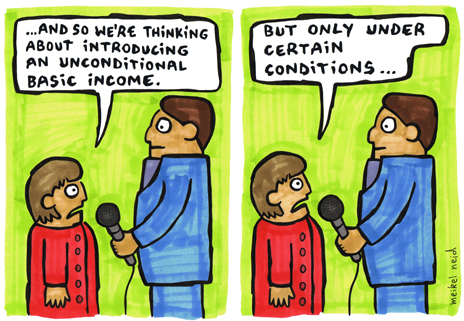
I’ve always liked Meikel Neid’s rough and very hand-made looking style. Something about the edgy and weirdly unstable outlines tells me that his cartoons take longer to draw than you would expect. This Friday, February 12, an exhibition of his works will open in Berlin. It is tied to a political campaign endorsing the introduction of a Basic Income Guarantee (see the interview for more details). While I remain skeptical about the concept, I thought it interesting to talk to an artist who has lent his work to a political cause. This is an interview about political art.
UPDATE: photos added. see page 2
![]() Meikel, starting on February 12 some of your cartoons will be on display as part of an initiative called “Illustrating Basic Income Guarantee“… Could you briefly describe what this is all about?
Meikel, starting on February 12 some of your cartoons will be on display as part of an initiative called “Illustrating Basic Income Guarantee“… Could you briefly describe what this is all about?
Well, the basic concept of BIG is to provide each person in this country with a certain amount of money without imposing any further conditions. This means you don’t need to provide any proof that you are eligible and you are not required to take a job that you can’t do or don’t want to do. Of course there are different ideas about the extent of this unconditional income.. but the main idea is that people must be able to meet their basic needs.
“Illustrating Basic Income Guarantee” was initiated by [Berlin-based artist and politician] Annette Köhn. She asked me to contribute a couple of cartoons. I drew a small number of cartoons especially for the exhibition but the majority will be cartoons that just are somewhat political, socio critical .. or, well, not political at all.
So.. is Basic Income Guarantee a concept that you personally support?
Yes. I mean, I don’t think that everybody should receive 1,500 Euros per month so they won’t have to do anything at all. But it’s a good thing to take pressure and repressions off of people living on welfare.
Is it harder to do a cartoon on an issue that you support than on something you oppose?
No. Not really … When you are drawing a political cartoon you take your own opinion and then all you need to do is find the opposite to this opinion and build your cartoon around it.
In a way your cartoons could be considered “political art”, right?
Yes.
What do you think of political art?
That’s a bit tricky.. one of the disadvantages of political paintings, cartoons, etc. is that, as an artist, you need to get involved with the topic. Which isn’t always a pretty thing to do. You’re likely to get in a bad mood when you’re studying political topics. Of course artists at least get the satisfaction of creating something out of this mess.
Then, you also need to consider your audience. How complex can a political cartoon be while still being comprehensible? There are so many people who don’t care about politics. As an artist you sometimes feel a bit lost.
Is it possible to draw a line between political art and propaganda?
Nah… I don’t think I would draw such a line. Doing political cartoons in a way is promoting a cause that’s important to you or that you have been thinking about.
When doing political cartoons, how far can you go? How ‘mean’ can you be as an artist?
I don’t think there are any topics where you can’t be mean. You should be able to make jokes about everything. There are great cartoons about death, for example – cartoons that are completely tasteless but hilarious anyway.
… but “death” is not exactly a political topic..
Well, considering political topics, things get complicated as soon as you attack someone personally. I would rather draw a cartoon against Christianity than against Islam. I don’t really know why, though. Probably because I know Christianity better.
As for jokes directed at politicians.. in most cases they deserve it. If you enter politics and try to reach a high position you should expect criticism. If you can’t deal with that, you’re in the wrong place.
Are there any politicians that you respect so much that you wouldn’t make fun of them?
Not really. Jokes needn’t be vicious, after all. Sometimes amazing people have attributes or quirks that are funny. It’s absolutely OK to use that for a cartoon.
Thanks for your time!
Paul Hellmich
BEDINGUNGSLOSE BILDER von Meikel Neid
12. Februar bis 19. März 2010
Musenstube
Tellstr. 2, 12045 Berlin (Neukölln)
werktags 10-16 Uhr (flexibel)
Eintritt frei
]]>
verkündete 1949 die Titelseite von Heft 43 der Programmzeitschrift HÖRZU: „Äußerlich und innerlich gleichermaßen gutmütig, witzig und vielleicht stachelig. Prägen Sie sich sein Bild ein. Sie werden ihn von jetzt ab in jeder Nummer von HÖRZU sehen…“ Diesem ersten öffentlichen Auftritt von Mecki in HÖRZU war die intensive Suche nach einem geeigneten Maskottchen für die Programmzeitschrift vorangegangen. Der mit der Recherche beauftragte Bildredakteur war bei dem sich mühselig gestaltenden Unterfangen schließlich auf eine kleine Igelfigur gestoßen, die auf einem Trickfilmcharakter der Gebrüder Diehl basierte. Mit den bedauernden Worten „Was Besseres haben wir nicht“ präsentierte er die Igel-Puppe seinem Redaktionsleiter Eduard Rhein. Der Chefredakteur schloss den Igel augenblicklich in sein Herz und taufte ihn auf den Namen Mecki.
So entstand die bis heute langlebigste deutsche Comic-Serie, der das Wilhelm-Busch-Museum Hannover jetzt eine umfassende Retrospektive widmet. In der Ausstellung werden mehr als 200 Originalzeichnungen zu sehen sein, die sämtliche künstlerischen Perioden der wechselhaften und bis heute in steter Fortsetzung befindlichen Mecki-Historie abdecken.
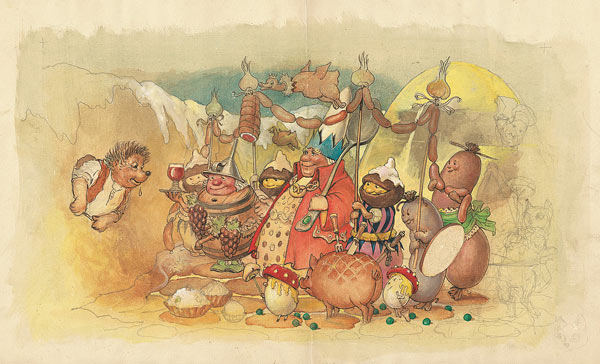
Am Anfang von Mecki standen zunächst die stimmungsvollen Aquarellbilder von Reinhold Escher, die sehr schnell großen Anklang bei den Lesern fanden. Während sich diese Bilder anfänglich noch auf der Witzseite der Zeitschrift den Platz mit anderen Zeichnungen teilen mussten, war es 1951 in Nummer 32 der HÖRZU soweit – Mecki durfte sich mit seinem ersten großen Abenteuer auf (fast) einer ganzen Seite ausbreiten. Nachdem die ersten Mecki-Comics noch in unregelmäßiger Folge erschienen, änderte sich dies ab dem Ende des Jahres 1953 grundlegend: Mit Die große Nummer erschien die erste Fortsetzungsgeschichte über die Abenteuer des mittlerweile äußerst populären Redaktionsigels. Es waren ganz besonders diese inhaltlich breit angelegten und sich über viele Fortsetzungen erstreckenden Geschichten, die entscheidend zum Mythos Mecki beitrugen.
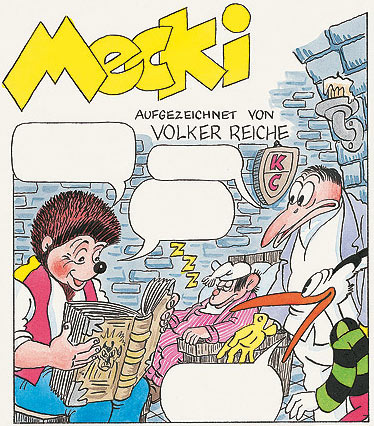
Nach Reinhold Escher trat 1958 ein weiterer Zeichner auf den Plan, der mit der Mecki-Welt bereits wohl vertraut war: Der versierte Pressezeichner und Maler Wilhelm Petersen gestaltete bereits seit einigen Jahren nach Texten von Eduard Rhein die äußerst beliebten Mecki-Bilderbücher, die von 1952 bis 1964 alljährlich zu Weihnachten erschienen. Als Reinhold Escher aufgrund gesundheitlicher Probleme seine Arbeit etwas reduzieren musste, teilte er sich fortan mit Petersen die Arbeit an den Mecki-Folgen in der HÖRZU. Das Experiment gelang, und alsbald stießen weitere Künstler hinzu. So verstärkte Heinz Ludwig das Zeichner-Team für vier Abenteuer, bevor es in den 1970er Jahren arg für den Comic-Igel kam: Mit seinem freundlichen und eher biederen Image schien Mecki nicht mehr in die Zeit zu passen. So wurde die Serie nur noch im Wechsel mit anderen Geschichten veröffentlicht, um ab 1978 beinahe ganz zu verschwinden. Dauerhafte Besserung zeichnete sich erst wieder 1985 ab. Jetzt übernahm Volker Reiche, der sich zuvor unter anderem als Donald-Duck-Zeichner einen Namen gemacht hatte, die Mecki-Geschichten. Auch wenn es immer wieder zeitweilige Versuche mit anderen Künstlern wie dem Zeichenstudio von Ully Arndt oder Harald Siepermann gab, war es Volker Reiche, der Mecki für zwei Jahrzehnten prägen sollte, bevor Ende 2006 Johann Kiefersauer neuer und bis heute amtierender Mecki-Zeichner wurde.
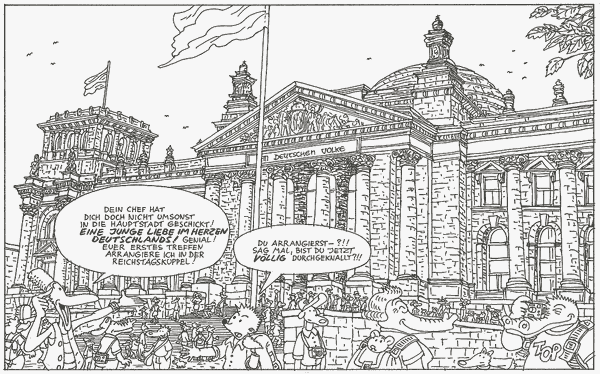
Von all diesen Künstlern zeigt das Wilhelm-Busch-Museum in seiner Ausstellung kostbare Originalzeichnungen. Hierunter befinden sich auch frühe, farbig angelegte Mecki-Comics, die in den 1950er Jahren in HÖRZU allerdings nur im Zweifarbdruck veröffentlicht worden sind. Daneben werden aber auch bisher unveröffentlichte Mecki-Comics präsentiert. Zu diesem Konvolut gehört u. a. die letzte Mecki-Geschichte von Reinhold Escher, dem Schöpfer der Serie, die in den 1970er Jahren leider in einer Schreibtischschublade der HÖRZU-Redaktion verschwand und jetzt in Hannover erstmals öffentlich präsentiert wird.
Begleitend zur Ausstellung wird Museumsshop eine Auswahl von Mecki-Büchern erhältlich sein.
Ausstellungsdauer 17. Januar bis 11. April 2010
Eröffnung Sonntag, 17. Januar 2010, 11.30 Uhr
Pressekonferenz Freitag, 15. Januar 2010, 11.30 Uhr
Öffnungszeiten Dienstag bis Sonntag 11-18 Uhr
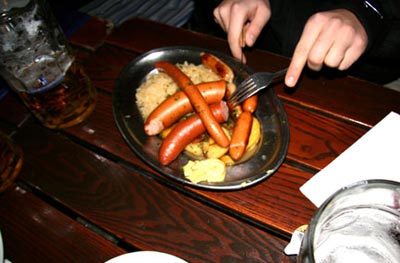
Hard work for a hungry man: 5 types of sausages with sauerkraut

the book-worms flock to their train
We all started our final day at the fair with a little cold we hat caught the day before, but we fought bravely against it with a lot of free christmassy tea from the Yogi-Tee booth at the other side of the hall. We had a lot of visitors this day, professional art directors and editors, photographers, cartoon and comic artists and curious people who got interested, because we didn’t show photographs like all the other image agencies around us.
The signing session was not really well attended, mostly due to the fact that we didn’t do much advertisement for it on the fair. It didn’t show up in the catalogue and schedules around the fair – we signed to the fair very late, after the deadlines of all the catalogues, flyers and press material that was printed for the fair. However, many of the little signing sessions and public readings of unknown and popular authors among the fair weren’t popular either. The visitors flocked to the stands as soon as they heard the popping of opened sparkling wine bottles.
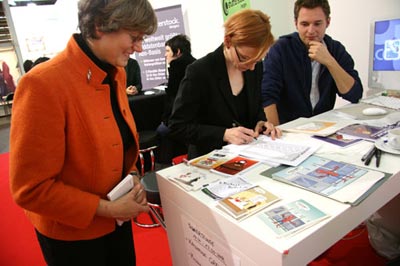
kagreve does excellent fan treatment
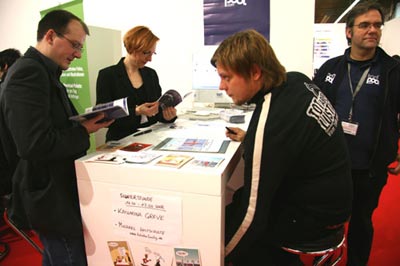
Michael Holtschulte signing art prints
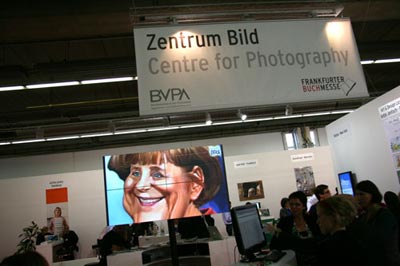
Tonió's great Merkel caricature on the big screen
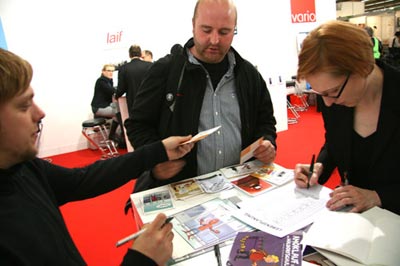
An art teacher is interested in postcards
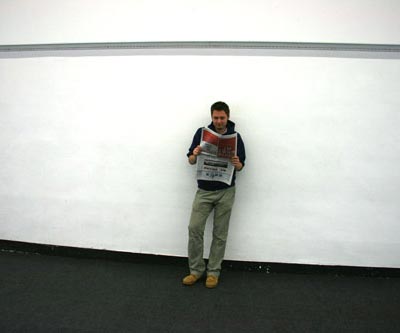
I try to read a Chinese newspaper in the country's section
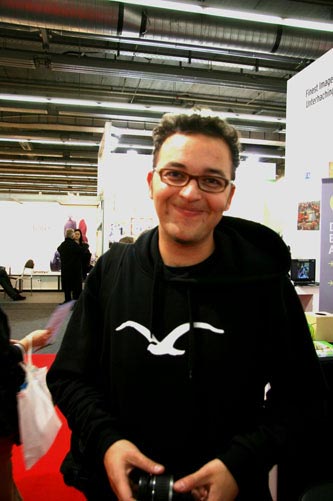
A seldom photograph of the photographer
In the end of the 3rd and final day at the fair, Nils, Frank and I were exhausted, but content and happy. Personally, I enjoyed it. I have been on several fairs in my life like the automobile fair IAA and the consumer electronics fair IFA, both in Berlin, but the Frankfurt Book Fair was different. It was not about some shiny happy-making flatscreens and video games, not about fast or fancy little cars. this fair presented art, true art.
Of course, there was a lot of business going round there, people in black suits and suitcases making deals and contracts on one side and silly crime and love novels on the other side. But I had a feeling that all those people on the fair shared a true love or at least interest in art, in fantasy or in knowledge. I have to admit that I do not really like Frankfurt (though I just have been there for two times, I’m eager to get convinced of the opposite, dear Frankfurters!) and the way motorists are treated, but the atmosphere was mainly charming.
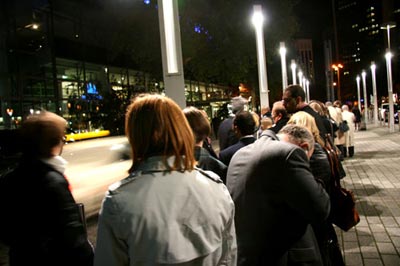
The fans are waiting for a taxi
Nils and I returned to Jan in Ladenburg (where we lived during the Fair) for the last time. We rushed through the county this evening with joy, visited a ska concert (Skall & Crossbone) in a youth club in Mannheim and the 25th anniversary party of the famous drum & bass club “Connection”.
The next day, the three of us and Jan’s housemate drove to the beautiful city of Heidelberg, where we climbed the approx. 300 steps of the stairs to the castle. You have a great vista up there on the valley of Heidelberg and the famous bridge, where, according to a legend, the former federal chancellor of Germany, Helmut Kohl, used to sit on in his student’s ages, eating apple puree. Some tourists from Russia and Japan asked me to make a snapshot of them with their cameras.
In the evening hours, Nils and I got on our 600 kilometers way back to Berlin. We had some great company – the radio stations of Hessia, Thuringia and Brandenburg played some great German folk music and nice Techno sets from the local discos while we flew over the dark autobahn.
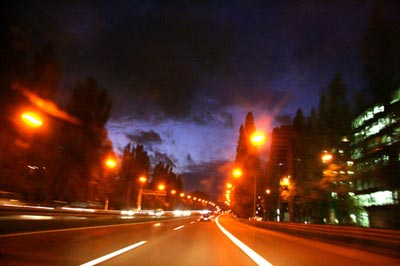
Exile on Main river (haha)

Back to the Berlin office on a Saturday night
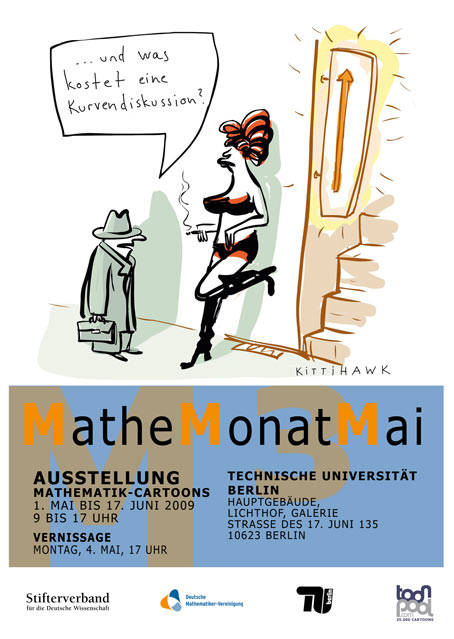
m3
Sind Mathematiker heimliche Humoristen? Kann eine Formel satirisch gemeint sein? Die Möglichkeit, dass dies so ist, lässt sich vermutlich mit der Wahrscheinlichkeitsrechnung annähernd genau ermitteln. Vermutlich, annähernd? Wörter, die Mathematiker “wahrscheinlich” nicht gern hören! Aber ist es nicht so, wie es ein alter New-Yorker-Cartoon zeigt: Ein kleiner Junge soll an der Schultafel, den Mathelehrer im Rücken, 1 und 1 addieren. Der Schüler hat auf der Tafel ganz links oben angefangen: 1 + 1 = 1 dann das Komma – und hinter dem Komma: 9999999999999999999… usw. über viele Zeilen, er nähert sich beim Rechnen schon der rechten unteren Ecke der Tafel, und der Lehrer lobt: Gleich hast Du’s! Möge dereinst die Fallhöhe einer Witzidee exakt berechenbar sein, eine große Aufgabe für die Forschung! Die Cartoon-Künstler warten jedenfalls sehnsüchtig darauf…
Cartoonpreis 2008
Vernissage: Montag, 4. Mai 2009, 17 Uhr
Ort:
Technische Universität Berlin
Hauptgebäude, Lichthof, Galerie
Straße des 17. Juni 135
10623 Berlin
(Nähe Ernst-Reuter-Platz)
—————————————————————————————————————-
Statement Prof. Günter M. Ziegler, Pastpräsident der Deutschen Mathematiker-Vereinigung (DMV) und Koordinator des Jahrs der Mathematik 2008 für die DMV:
Sehr verehrte Damen und Herren,
ich möchte Sie herzlich einladen, sich mit uns ein Projekt im MatheMonatMai anzuschauen: Eine Ausstellung von Mathematik-Cartoons an der TU Berlin. Die Ausstellung ist in mehrfacher Hinsicht bemerkenswert. Sie werden sehen: Die Mathematik eignet sich durchaus für einen humoristischen Umgang. Bemerkenswert war auch die Resonanz auf die Ausschreibung eines Cartoonpreises für Mathematik durch die DMV 2008: sie war enorm groß; rund 250 Cartoons wurden von 150 Künstlern eingereicht – das hat uns sehr gefreut. Diese außergewöhnlichen Cartoons müssen wir einem breiten Publikum verfügbar machen.
Die Mathe-Cartoonausstellung zeigt, dass die Mathematik ein frisches fröhliches Gesicht hat, das auch mit dem Auge zwinkern kann. Die Ausstellung ist offiziell ab dem 1. Mai zu sehen; wegen des Feiertages am 1.Mai findet die Vernissage am Montag, 4. Mai, 17 Uhr im Lichthof statt – zu dieser Veranstaltung möchte ich Sie herzlich einladen.
Günter M. Ziegler
—————————————————————————————————————-
Die Location:
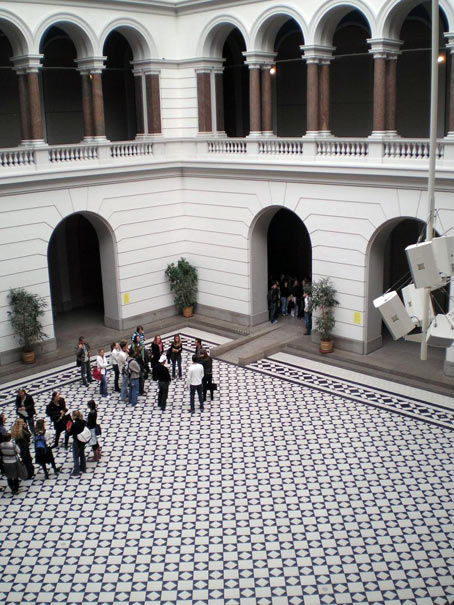
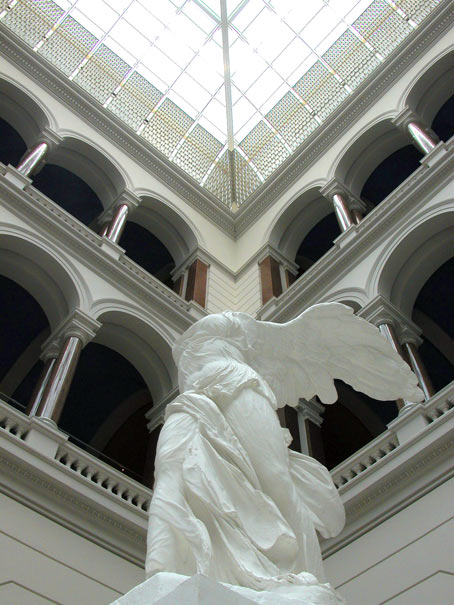
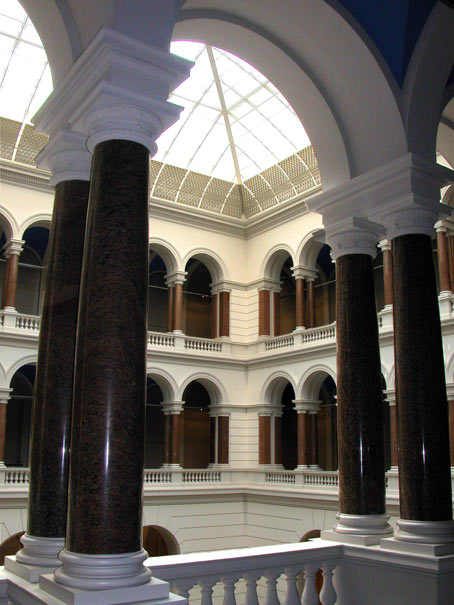
—-
Einige Arbeiten der Ausstellung:
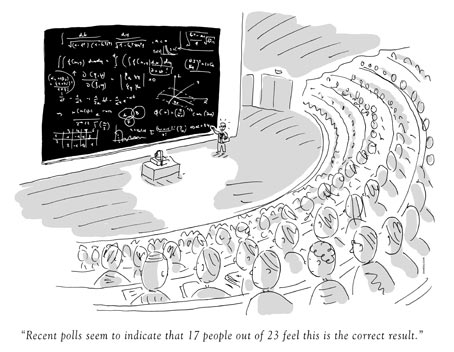
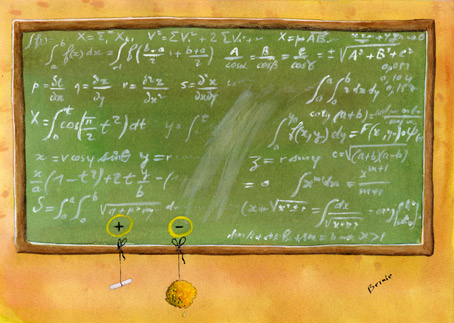
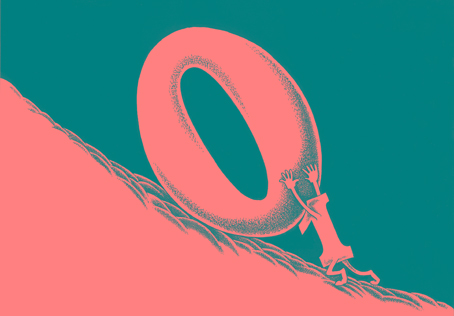

Noch mehr Informationen zum MatheMonatMai befinden sich auf der DMV-Homepage
—————————————————————————–
NACHTRAG: FOTOS DER VERNISSAGE GIBT ES HIER!
—————————————————————————–
Flix: die Cartoons
Dauer der Ausstellung: 21. März – 10. Mai 2009
Cartoonfabrik, Krossener Straße 23, 10245 Berlin-F’Hain
(Am Boxhagener Platz), MI-SO 14:00h – 19:00h
——
Hier ein paar Bilder von der Vernissage in der Cartoonfabrik, Berlin:
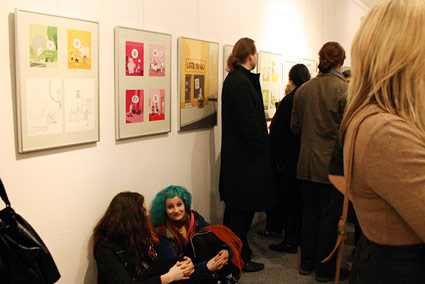
Full house.
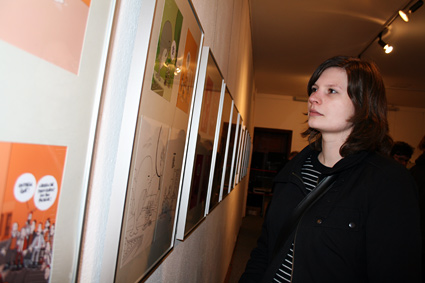
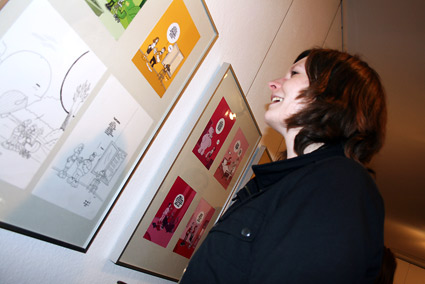
Da kann keiner ernst bleiben.
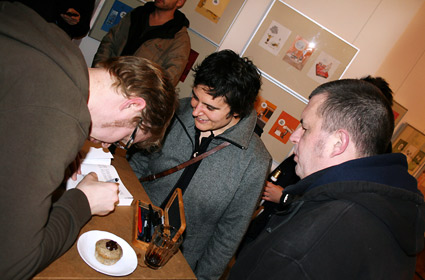
Schlange bei der Signierstunde. Cartoonist Flix beim Anfertigung einer Zeichnung für Kittihawk. Daneben Bernd Pohlenz.
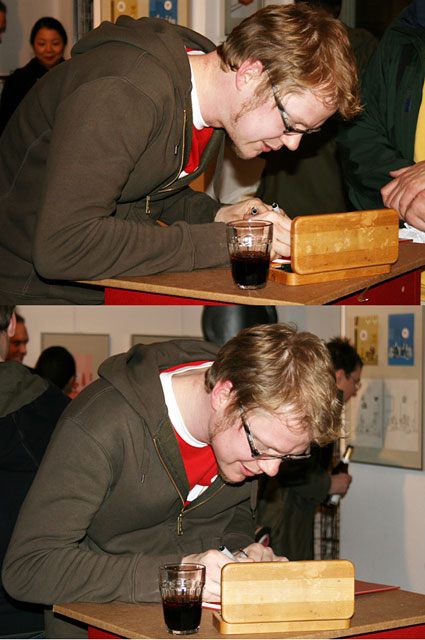
Marathon.
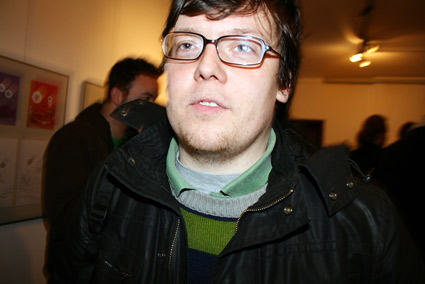
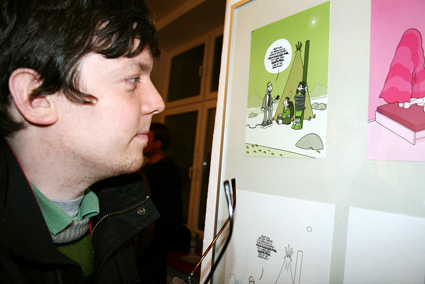
Zeichner und Grafiker Kamil trägt die passende Farben.
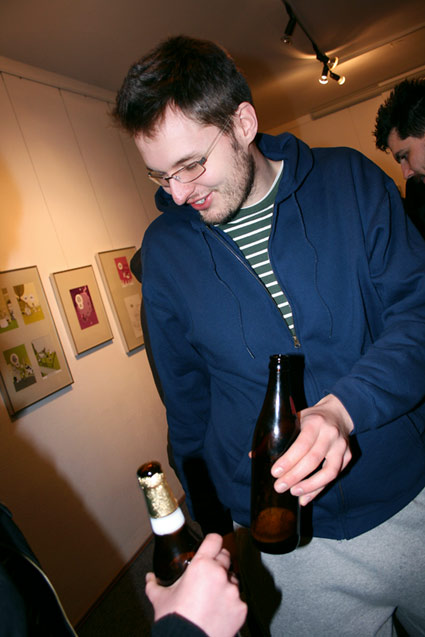
Gute Stimmung.
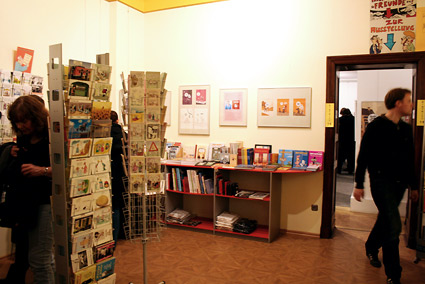
Eröffnung am 20. März 2009 um 20 Uhr
(Mit Alkohol und kleiner Live-Lesung von Ralph Ruthe und Flix)
Dauer der Ausstellung: 21. März – 10. Mai 2009
Cartoonfabrik, Krossener Straße 23, 10245 Berlin-F’Hain
(Am Boxhagener Platz), MI-SO 14:00h – 19:00h
FLIX – DIE CARTOONS
Seit gut sieben Jahren zeichnet der Comiczeichner und Illustrator Flix auch Cartoons. Unter dem Label Verflixt werden sie in verschiedenen Zeitungen abgedruckt. Seit Anfang dieses Jahres erscheint täglich ein Cartoon im Internetportal web.de.
Flix (Jahrgang 1976) gehört zu der Generation von Zeichnern, die mit dem Computer groß geworden sind und die Möglichkeiten der modernen Technik inzwischen für ihre Arbeit benutzen. So sind seine fertigen Cartoons keine Originale mehr, sondern Daten, die man ausdrucken kann. Während andere aber nicht einmal mehr Stift oder Pinsel benutzen, zeichnet Flix zunächst mit der Hand. Mit hartem Bleistift fertigt er auf einem relativ dicken Karton eine Skizze an, aus der dann eine mit schwarzem Feinliner gezeichnete Vorlage wird. Die Bleistiftstriche radiert er weg. Nach dem Einscannen bearbeitet Flix diese Vorlage nicht nur farbig per Computer, er schiebt Sprechblasen und Figuren hin und her, fügt neue Details ein, bis er die perfekte Konstellation für seinen Bildwitz gefunden hat. Heraus kommen farbintensive Cartoons, die sich vor allem immer wieder dem Thema Nummer eins des Lebens widmen – dem Alltag zwischen Mann und Frau.
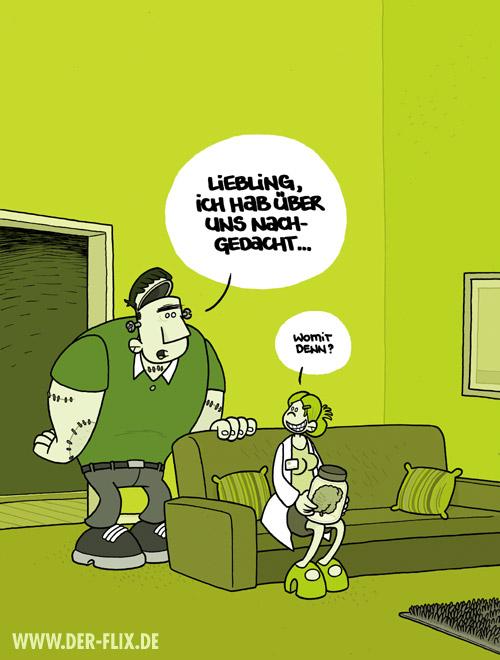
2005 veröffentlichte Carlsen die erste Sammlung dieser Cartoons unter dem Titel „Verflixt -…und jetzt?!
Zur Ausstellung in der Cartoonfabrik erscheint der zweite Band mit dem Titel „Verliebt!“ (64 Seiten/100 Cartoon/9,95€). Die Cartoonfabrik zeigt ca. 120 Cartoons von Flix zusammen mit etwa 30 Vorlagen und liefert so dem Betrachter die Möglichkeit, die Entwicklung der Bilder nachzuvollziehen.
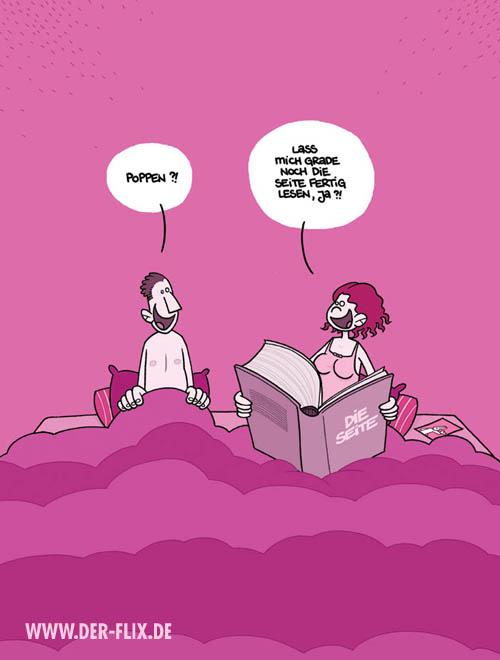
Flix ist 1976 in Münster/Westfalen geboren, in Darmstadt aufgewachsen und lebt und arbeitet heute als freier Comic- und Cartoonzeichner und Illustrator in Berlin. Er studierte in Saarbrücken und in Barcelona Kommunikations-Design. 1998 veröffentlichte er angeregt von dem Cartoonzeichner Peter Butschkow, seinen ersten professionellen Comic „Who the fuck is FAUST?” (Eichborn), der ab April 2009 in komplett überarbeiteter Form als täglicher Strip in der FAZ erscheinen wird. 2003 erschien bei Carlen Comics seine Diplomarbeit „held”, die mit einigen Preisen ausgezeichnet wurde, u.a. mit dem „Lucky Strike Junior Designer Award“ und dem „Max-und- Moritz-Preis 2004“ als „Beste deutschsprachige Publikation”. In dieser Geschichte erzählt Flix sein gesamtes Leben von der Geburt bis zum Tod, also Vergangenheit, Gegenwart und Zukunft. Bisher wurde „held“ in spanisch, französisch und koreanisch übersetzt. Mit „sag was” und „mädchen” komplettiert Flix seinen
biografischen Comic. Sein Comic „Da war mal was” mit Episoden aus dem geteilten Deutschland erscheint regelmäßig im Berliner Tagesspiegel. Zum Jubiläum des Mauerfalls werden diese Geschichten bereits im August 2009 in Buchform bei Carlsen veröffentlicht.
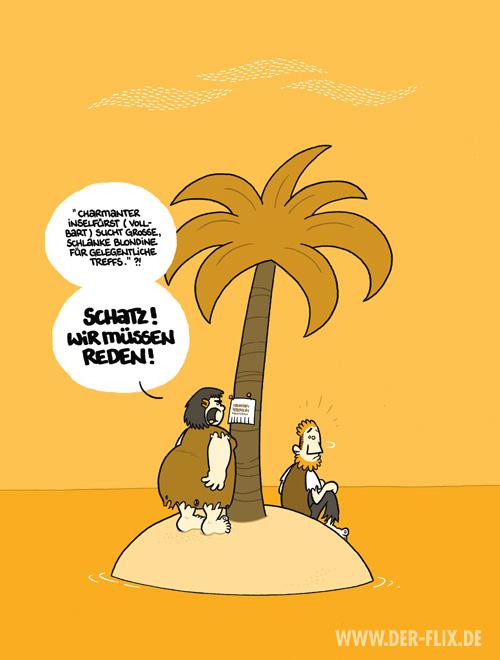
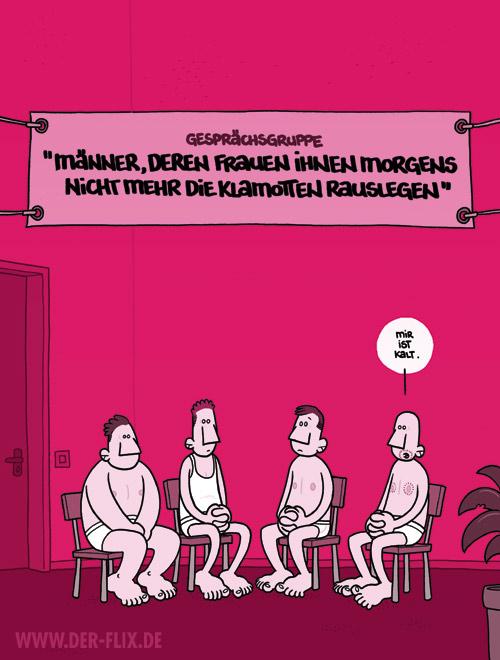
Eröffnung: Freitag, 20.3.2009
Mit Flix & Ralph Ruthe & Ausschnitten aus ihrem Programm „Mädchen, Monster, Missgeschicke“
—-
NACHTRAG:
HIER Bilder von der Vernissage!
—–
BERND ERTL, geboren 1971 in Wagna, Steiermark, ausgebildet an der Graphischen Lehranstalt, Wien, in London und in Brisbane, hat sich mit seinen Storyboards und Illustrationen in der internationalen Werbebranche bereits einen Namen gemacht. Jetzt tritt er mit dieser ersten, großen Einzelausstellung als Karikaturist in die breite Öffentlichkeit.
Ausstellung “Demontage” von Bernd Ertl vom 3. bis 28.März 2009
Sie und Ihre Freunde sind herzlich eingeladen.
GALERIE AUGUSTIN
Lugeck 3, 1010 Wien
Tel. & Fax: 01 / 512 62 70
mobil: 0676 / 7000 482
[email protected]
www.galerie-augustin.com
Öffnungszeiten:
Dienstag – Freitag: 11 – 13 und 14 – 18 Uhr
Samstag: 11 – 15 Uh
Zur Vernissage eingeladen: Literatur-Nobelpreisträgerin Elfriede Jelinek:

Elfriede Jelinek
-

Pierluigi Collina
Bernd Ertl: In einer Zeit, in der man durch die Tätigkeit der kulinarischen Insektenvertilgung in die Medien kommt, war es mir ein Anliegen das Image mancher Stars etwas zu zerlegen, zu demontieren – ergo der Titel “Demontage”. Dennoch portraitiere ich hauptsächlich Menschen, die mir persönlich sympathisch sind – die meisten meiner Bilder sind eher eine kleine Huldigung, und nicht wirklich böse gemeint. Die Überhöhung ist für mich auch ein Mittel die Persönlichkeit eines Menschen zu komprimieren und das für mich Wesentliche zu zeigen.

Kaiser Palfrader

Stefanie Graf

Bernd Ertl, Giclée, "Ben Stiller" Auflage: 3 Exemplare, 80 x 60 cm

Luciano Pavarotti

Anna Netrebko

André Rieu

Joe Zawinul
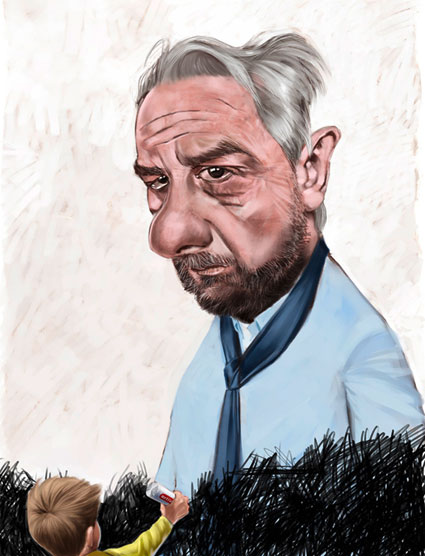
Arnulf Rainer
Weitere Portraits u.a. von: Angelina Jolie, Bruce Willis, Dean Martin, Dita von Teese, Kurt Russell, Amy Winehouse, Andre Rieu, Anna Netrebko, Joe Zawinul, Luciano Pavarotti, Sting, Andy Warhol, Arnulf Rainer, Damien Hirst, Herbert Prohaska, Hermann Meier, Pepi Hickersberger, Stefanie Graf, Thomas Muster.
See also more work of Bernd Ertl on toonpool
—
Pictures from the Exhibition:
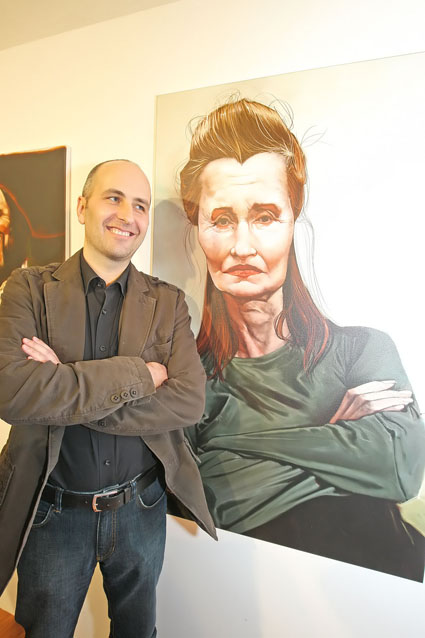
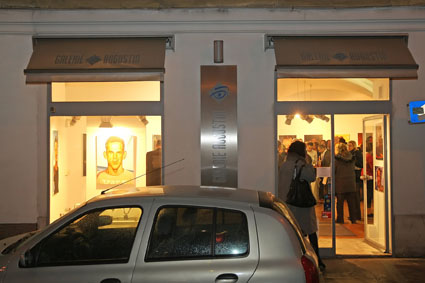
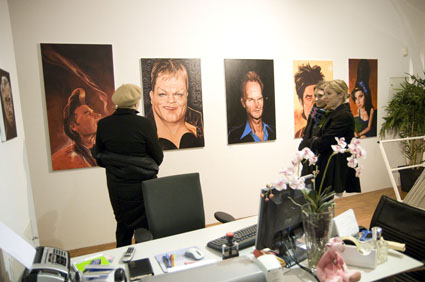
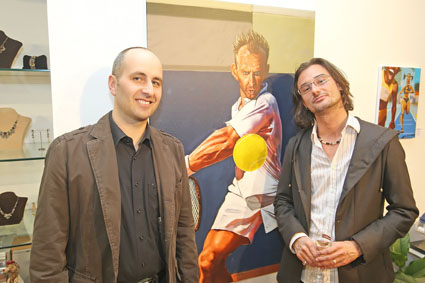
Bernd Ertl and gallerist Sascha Augustin
]]>
